If I say “Pisa” the leaning tower is the first thing that pops into people’s minds almost straight away. And, of course, those millions of photos circling around the internet, where everyone thinks that they are “holding” this building in the most unique way possible. And no. They are not. Oh, and I almost forgot to mention that super old Sport chocolate advert, where a Bob Marley doppelgänger is riding a motorbike when he spots a tourist posing-as-if-he-would-be-holding the tower, he quickly jumps off his vehicle and with all his strength gained from eating the chocolate helps the unsuspecting man straighten the tower. He then vanishes in the crowd. You can watch this masterpiece here.
Ha azt mondom Pisa, az emberek többsége azonnal a ferde toronyra gondol. Na meg az interneten terjedő tengernyi képre, ahol mindenki azt hiszi, hogy kivételesen kreatívan “támasztja” az épületet, közben pedig nem is. És akkor majdnem elfelejtettem megemlíteni azt a régesrégi Sport szelet reklámot, melyben egy Bob Marley hasonmás a városban motorozva kiszúr egy tornyot támasztva fényképezkedő, gyanútlan turistát, azonnal lepattan járgányáról, sport szelettől duzzadó izmaival segít kiegyenesíteni az épületet, majd dolga végeztével továbbáll. Ezt a mesterművet egyébként itt lehet megtekinteni.
We arrived to Pisa from La Spezia by train and our main priority was to locate our accommodation and get rid of our backpacks. When we booked our accommodation we chose a guesthouse called Casa San Tommaso, which is about 30 minutes away from the train station by foot, but only one block away from the leaning tower and the Cathedral Square. From the outside the guesthouse looks very modest, old fashioned, and a little bit like a primary school. Its thick walls manage to keep the hot summer air away. Once you step through the main door you’ll notice that the interior has a strange monastery/wine cellar mood. In general I wouldn’t spend such a long time talking about accommodations, but this guesthouse was unusually charming.
Mi La Speziából vonattal döcögtünk át Pisába, majd első dolgunk egyből az volt, hogy megtaláljuk a szállást és ledobáljuk a cuccainkat. Szállásfoglaláskor valamiért a Casa San Tommaso vendégházra esett a választásunk, ami gyalog kb. 30 percnyire van a vonatállomástól, viszont csak egy utcányira a ferde toronytól és a Dóm tértől. Kívülről ez egy nagyon egyszerű, régimódi, iskolaszerű épületnek néz ki, melynek vastag falaitól a nyári forróság is visszahőköl, ugyanakkor az épület belső kialakítása valamiféle megfoghatatlan kolostor-borospince hangulatot idéz. Alapvetően nem szoktam szállásokat ilyen hosszan ecsetelni, de valamiért ez a hely kivételesen tetszett.
As soon as we put the backpacks down we headed towards the famous leaning tower. Our first impression was that it’s way smaller than what you would expect based only on pictures. However, on the photo below you can easily see the proportions: a neighbouring two-story building covers more than half of the tower.
Amint sikerült megszabadulni a hátizsákoktól, azonnal a ferde torony felé vettük az irányt. A legelső benyomásunk az volt, hogy a torony sokkal kisebb, mint amilyenre az ember a képek alapján számít. Az alábbi fotón elég jól láthatóak a méretarányok, mivel egy szomszédos, kétemeletes épület több mint a felét eltakarja.
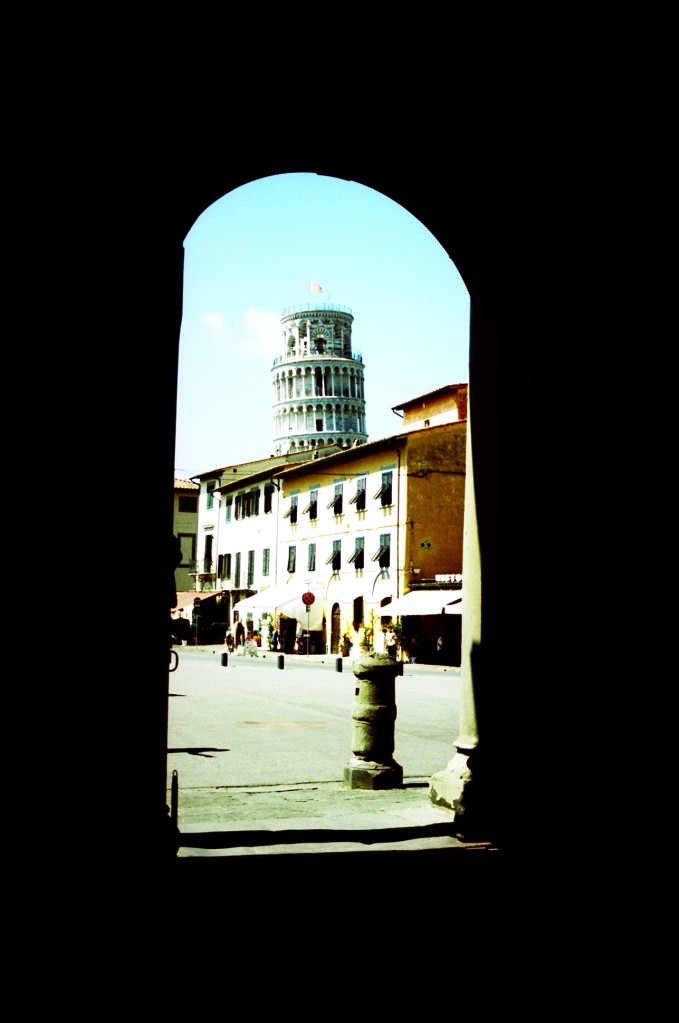
(Photo by Will)
Once we got closer our first impression was straight away replaced by a pretty mean thought: the Cathedral Square is a pretty amazing location for sneaking behind people and tickling them.
Közelebb érve ezt az első benyomást az a gonosz ötlet váltotta le, hogy a Dóm téren milyen tökjól lehetne emberek mögé lopakodni és jól megcsiklandozni őket.
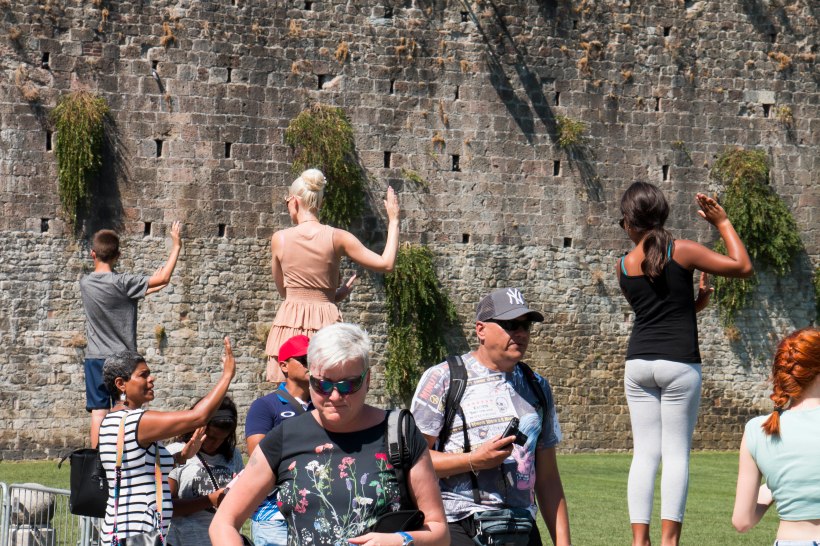
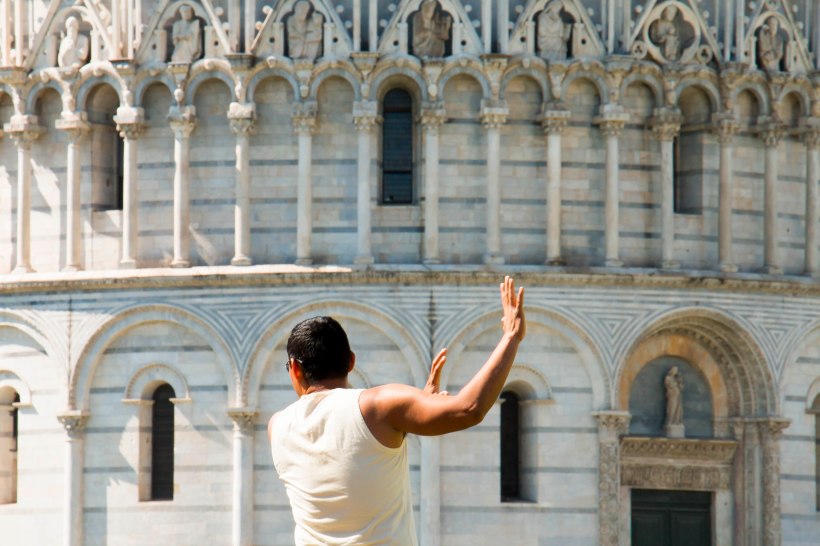
In the end, instead of tickling people we realised it’s lunchtime, we picked a restaurant, had a big meal, bought some cold drinks in the Pam supermarket nearby (where all prices were about one third of the Cathedral Square tourist prices), returned to our accommodation to rest for a little while and fell asleep completely unintentionally. Luckily, we managed to wake up soon so we returned to the city centre feeling refreshed and full of energy.
Végül csiklandozás helyett inkább kiszemeltünk egy ebédelőhelyet, belakmároztunk, a közelben található Pam nevű szupermarketben szereztünk hideg innivalókat (itt a nem turista áraknak köszönhetően minden harmadannyiba került mint a Dóm téren), majd visszamentünk a szállásunkra pihenni egy picit, aminek mondjuk az lett a vége, hogy jól el is aludtunk. Szerencsére nem aludtuk át a napot, viszonylag hamar felébredtünk és újult erővel tértünk vissza a városba.
The Cathedral Square consists of five important buildings: the cathedral (Cattedrale di Pisa), the leaning tower (Torre di Pisa), the baptistery (Battistero), the cemetery (Camposanto) and the Sinopie Museum (Museo delle Sinopie).
A Dóm térnek öt meghatározó épülete van: a dóm (Cattedrale di Pisa), a ferde torony (Torre di Pisa), a keresztelőkápolna (Battistero), a temető (Camposanto) és a Sinopie múzeum (Museo delle Sinopie).
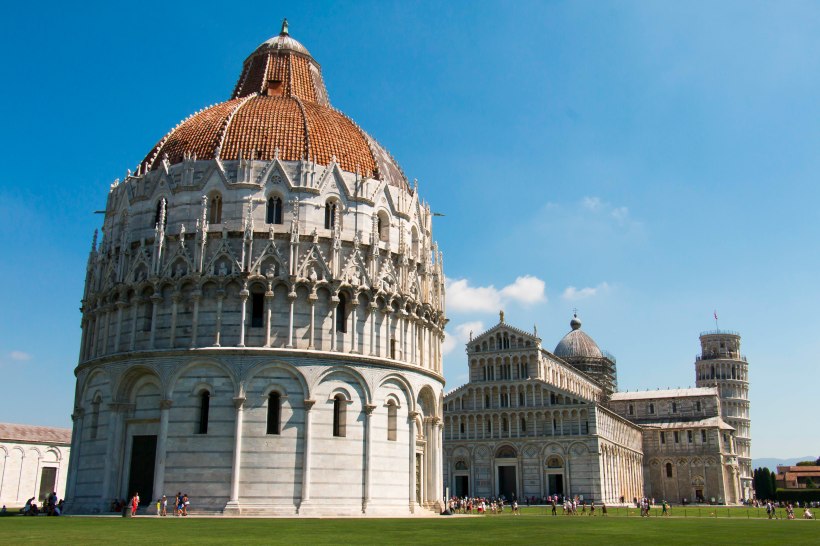
Piazza del Duomo
The Cathedral (also called the Cathedral of Santa Maria Assunta) was built between 1064 and 1092 in Romanesque style with a structure composed of five naves. This is the only building of the square that can be visited for free, however, you can’t just walk in and out as you wish. You will need to get a free ticket with an entry time from the ticket office in the Sinopie museum. Because the cathedral is very popular and the waiting time can be pretty long, this should be the first thing you do once you arrive to the Cathedral Square. You can buy additional passes for any of the other buildings at the same ticket office. Important detail: if you purchase any ticket, you gain entry to the cathedral without a time restriction.
A Dóm, hosszabb nevén a Santa Maria Assunta Dóm egy római stílusú, 5 hajós katedrális, melynek építését 1064-ben kezdték és 1092-ben fejezték be. A téren ez az egyetlen épület, ami ingyenesen látogatható, viszont nem lehet csak úgy kedvünkre ki-beslattyogni, hanem egy adott időpontra szóló ingyenes jegyet kell szerezni a Sinopie múzemban található jegyirodából. A térre érkezve érdemes ezt az ingyenes jegyet azonnal beszerezni, mivel a katedrális nagy népszerűségnek örvend és elég hosszú a várakozási idő. Ugyanitt lehet belépőt vásárolni a többi épületbe is. Fontos részlet: ha az ember belépőt vásárol bármelyik másik épületbe, azzal együtt egy ingyenes és időpont nélküli jegyet is kap a katedrálisba.
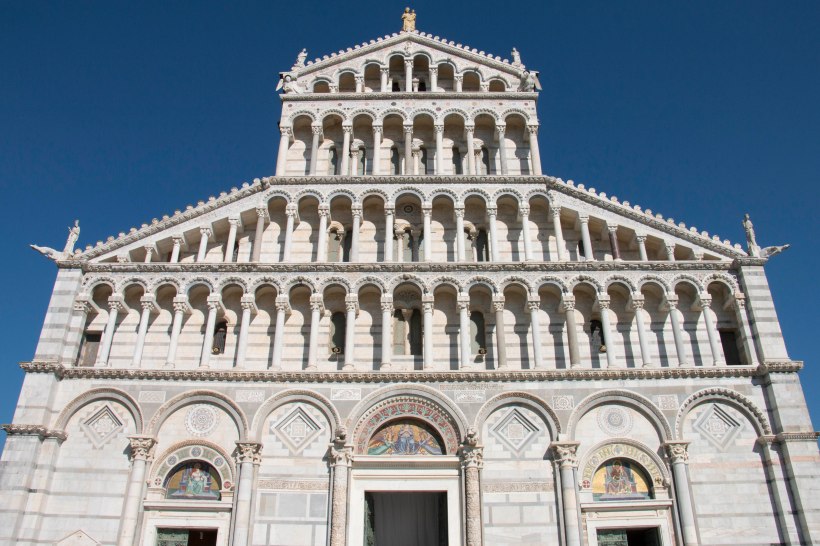
Cattedrale di Pisa
One of the many unique features of the leaning tower is the fact that it’s the freestanding bell tower of the cathedral. It was built using white marble, it weighs 14,500 tons, the construction happened in three stages over 200 years, and its history is very unusual. I think it’s going to be easier to follow if I use bullet points here.
-
The ground floor together with the first two floors were constructed between 1173 and 1178. Due to the sandy-clayey soil and a mere three-metre foundation the half-finished tower started to sink instantly. Construction was halted for almost a century.
-
In 1272 construction resumed and an additional four floors were built in an angle that somewhat compensated for the initial tilt. As a consequence, the tower isn’t only leaning but it’s also curved.
-
The seventh floor was completed in 1319 and seven bells were added in 1372.
-
According to the legend in the 16th century Galileo Galilei dropped two cannonballs of different masses from the top of the tower to demonstrate that their speed of descent was independent of their mass. Despite the fact that physics historians question the authenticity of this experiment the story became very famous.
-
In 1838 a path was dug around the tower in order to uncover its ground floor, but this made things worse and the tower slanted even further.
-
This was followed by Mussolini coming to the conclusion that the leaning tower of Pisa is a disgrace of Italy and something has to be done in order to straighten it. He thought that the best solution is to drill holes into the foundation and fill them up with concrete. Surprise surprise, this intervention only aggravated the issue.
-
During World War II the Allies demolished most towers in Pisa because they suspected that the Germans were using them as observation points. The leaning tower was spared from destruction only last minute when the artillery strike was cancelled.
-
In 1964 the Italian government asked for international help. A group of engineers, mathematicians and historians gathered on the Azores islands in order to come up with the best stabilisation method. In January 1990 the tower was closed, the bells were removed to relieve some weight and the building was anchored from its third level using cables.
A ferde torony egyik különlegessége, hogy a katedrális harangtornya, ennek ellenére a katedrálistól távolabb helyezkedik el. A torony fehér márványból készült, tömege 14,500 tonna, építése 200 évig tartott, három szakaszban történt és története igencsak rendhagyó. Pontokba szedve azt hiszem átláthatóbb.
-
1173 és 1178 között megépült a torony földszintje és az első két emelete. A homokos-agyagos talajnak, az alig 3m mély alapnak és a márvány tömegének köszönhetően a félkész épület azonnal eldőlt, a munkálatok pedig közel 100 évig szüneteltek.
-
1272-ben az építkezés folytatódott és további négy emelet épült, méghozzá olyan szögben ami kiegyensúlyozza valamennyire az eredeti dőlést. Ettől aztán a torony már nem csak ferde volt, hanem görbe is.
-
A hetedik emelet 1319-ben készült el, majd 1372-ben a torony végre hét haranggal is gazdagodott.
-
A legenda szerint a 16. században élő Galielo Galilei két eltérő tömegű golyót dobott le a torony tetejéről, ezzel bizonyítva azt hogy a testek tömegüktől függetlenül gyorsulnak. A kísérlet elvégzését a fizikatörténészek kétségbe vonják ugyan, de attól még a sztory elterjedt.
-
1838-ban utat ástak a torony körül, hogy a földszintje újra láthatóvá váljon, de ez csak rontott a helyzeten és a torony tovább dőlt.
-
Ezt követően Mussolini arra a következtetésre jutott, hogy a Pisai ferde torony Olaszország szégyene, és tenni kell valamit annak érdekében, hogy kiegyenesítsék. Az tűnt a legjobb megoldásnak, hogy lyukakat fúrnak a torony alapjába és feltöltik betonnal. Ez persze nem hogy javított volna, hanem inkább rontott a helyzeten.
-
A második világháború alatt az amerikai hadsereg majdnem minden pisai tornyot lerombolt, mivel azt sejtette, hogy a német csapatok ezeket megfigyelő pontoknak használják. Végül az utolsó pillanatban mégis visszavonták a robbantásról szóló parancsot.
-
1964-ben az olasz kormány nemzetközi segítséget kért. Ekkor egy mérnökökből, matematikusokból és történészekből álló csoport összeállt (az Azori szigeteken találkoztak), hogy kidolgozzák a stabilizálás legjobb módszerét. 1990 januárjában a tornyot lezárták, a harangokat elszállították, hogy ezzel is csökkenjen a terhelés és a harmadik szintről kábelekkel lehorgonyozták az épületet.
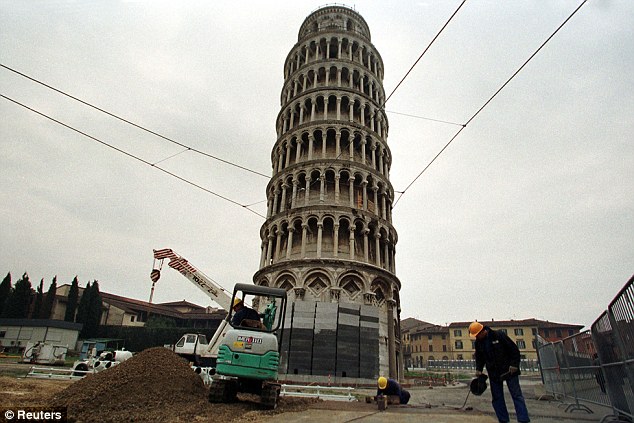
(Source: Reuters)
-
In 2001 the tower was reopened and despite of its obliquity it was declared stable for at least another 300 years. After the restoration works the cables were removed but the anchors stayed and can be seen right next to the Palazzo dell’Opera.
-
2001-ben a torony újra megnyílt a látogatók előtt, és ferdesége ellenére állítólag további 300 évig stabil marad. A munkálatok után a kábeleket eltávolították, a horgonyok viszont a mai napig láthatóak a Palazzo dell’Opera mellett.
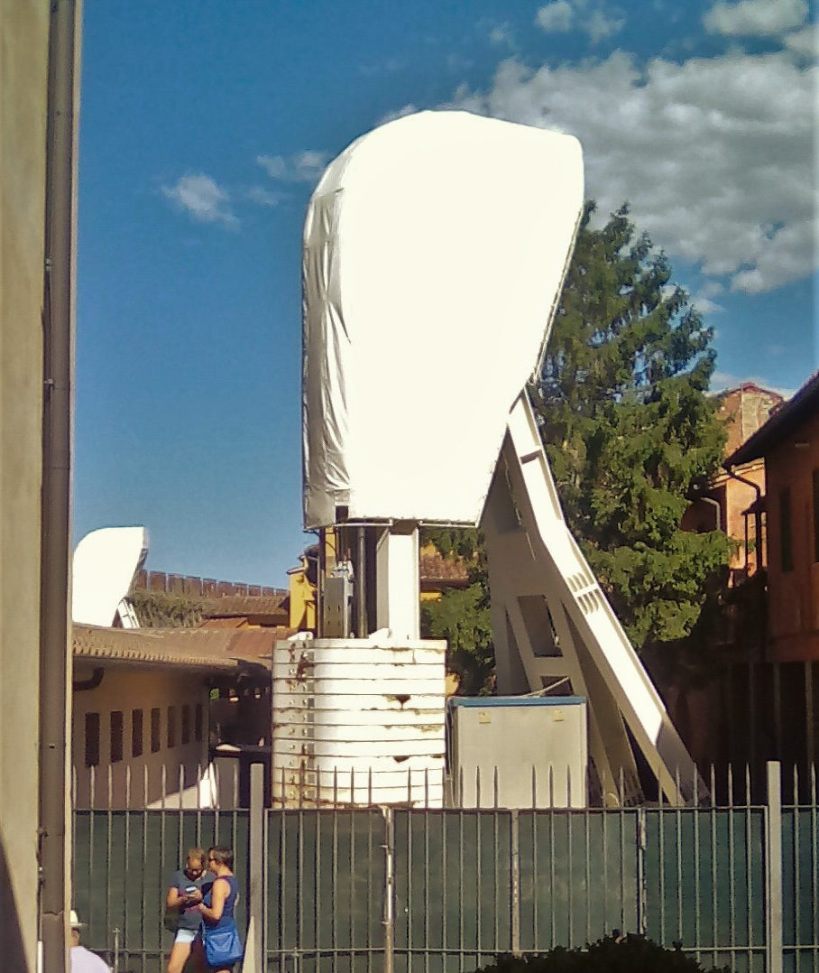
(Source: Atlas Obscura)
The tower is 55.86m tall on the lowest side and 56.67m tall on the highest side. Before the restoration works its angle of slant was 5.5 degrees which then was reduced to 3.99 degrees. This means that the vertical distance between the tip and the foundation is 3.9 metres.
A torony most 55.86m magas az alacsonyabbik oldalán és 56.67m a magasabbik oldalán. Dőlésszöge a restaurálás előtt 5.5 fok volt, utána pedig már csak 3.99. Ez annyit jelent, hogy a torony csúcsa és a torony alapja közötti vízszintes távolság 3.9m.
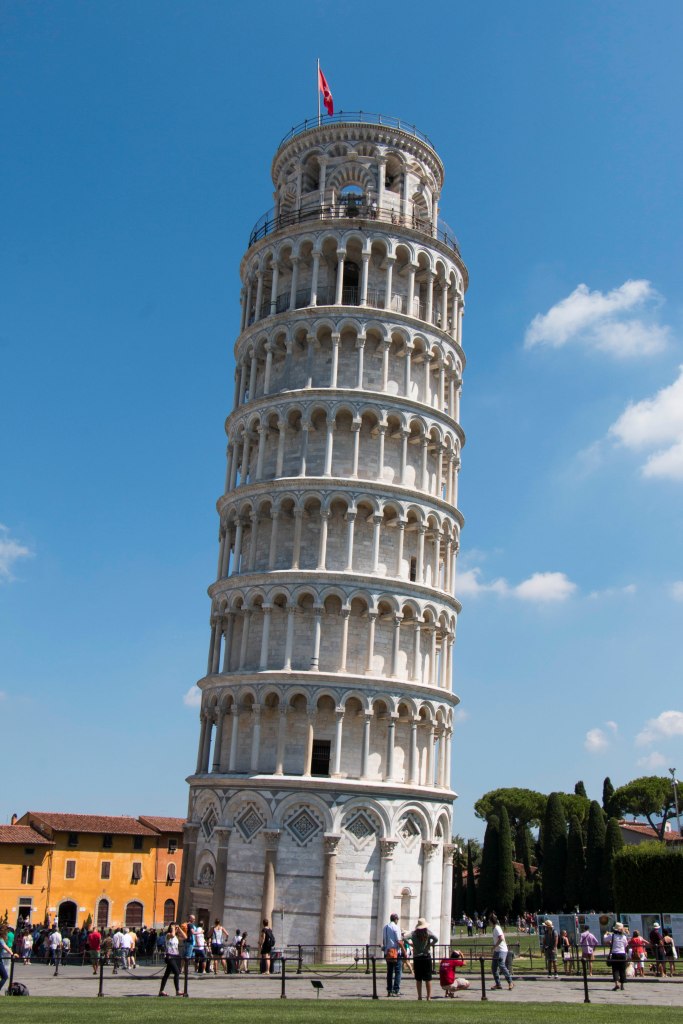
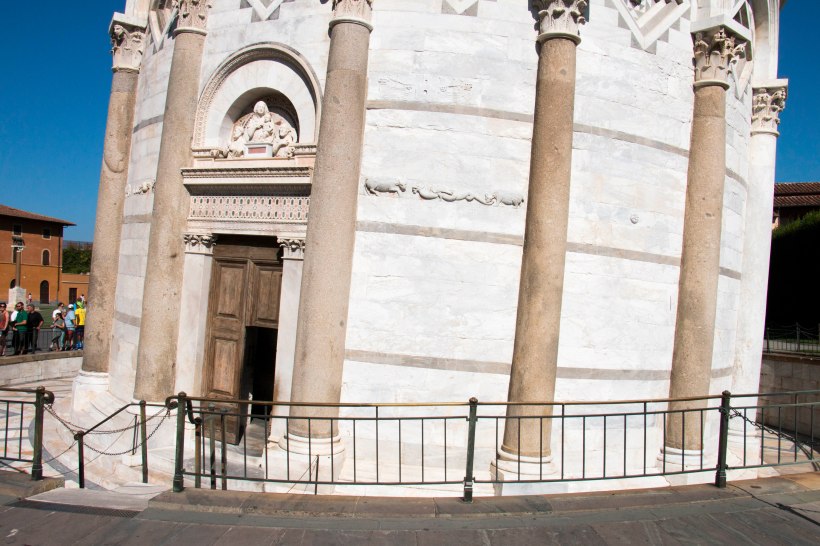
The entrance fee for climbing up the tower is €18, which we decided not to do for two reasons. On one hand we didn’t really want to queue, on the other hand because the tower itself is not that tall we felt that the actual view is not worth this amount of money and time for us.
Amúgy a toronylátogatás 18 euróba kerül, de mi ezt kihagytuk, mivel egyrészt nem volt kedvünk sorban állni, másrészt pedig mivel nem annyira magas, ezért a kilátás sem olyan hű de különleges, hogy számunkra megérje ennyi pénzt és időt rászánni.
The Battistero is Italy’s biggest baptistery: its circumference is 107.25m. We didn’t enter this building either, we just took a couple of photos from the outside instead.
A keresztelőkápolna, azaz a Battistero, Olaszország legnagyobb keresztelőkápolnája: kerülete 107.25m. Mi ide sem mentünk be, csak kívülről fotózgattuk különböző szögekből.
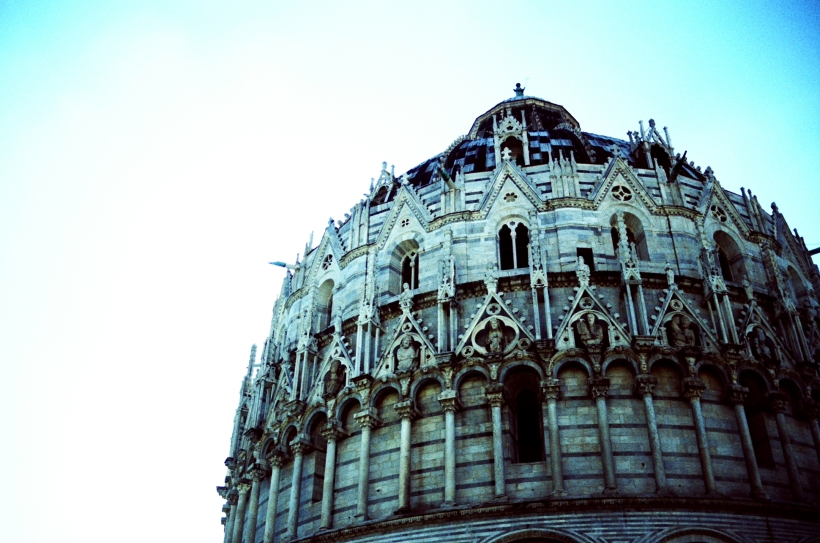
(Photo by Will)
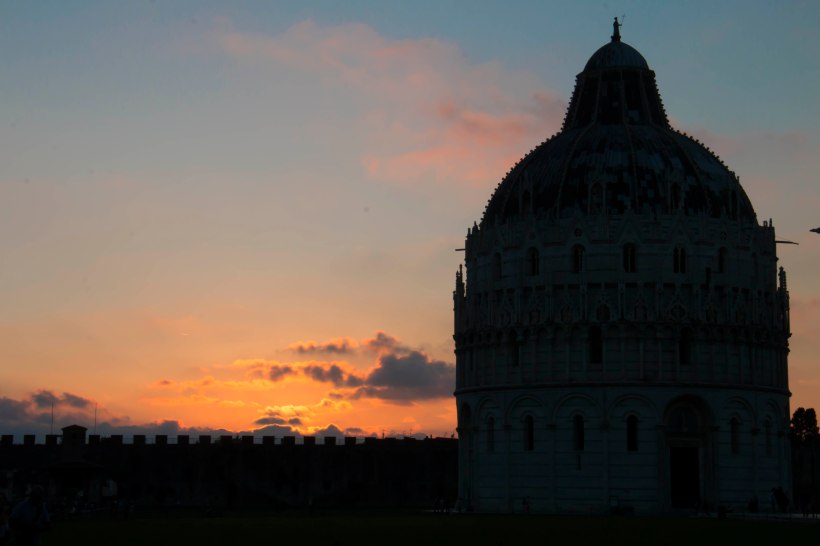
The cemetery, a.k.a the Camposanto, is a very simple, rectangular building without a single window on any of its walls. I think this is why I didn’t even take a photo of it, because from the Cathedral Square it doesn’t even look like a building, it seems to be a long wall. Inside, however, there is a big central lawn surrounded by an open corridor held by pillars and arches. Once upon a time the walls of this corridor were decorated with graffiti called frescoes back then. Unfortunately, most of these frescoes has been destroyed over time.
A temető, vagyis a Camposanto, egy szögletes, egyszerű épület, melynek a külső falán egyetlen ablakot sem nyitottak. Valószínűleg ezzel magyarázható, hogy az épületről én nem készítettem fotókat, mivel a Dóm térről nézve ez csak egy hosszú falnak néz ki. Odabent viszont egy zöld kert található, melyet egy oszlopos nyitott folyosó szegélyez. Ennek a folyosónak a falait korabeli graffitikkel, más néven freskókkal borították. Sajnos mára már nagy részük megsemmisült.
In order to find out more about the frescoes you’re better off visiting the Sinopie museum, where the original plans and outlines called sinopias are exhibited. Additionally, as I already mentioned, this is where you can get hold of all the tickets you might need for the buildings of the Cathedral Square, and you can also watch a short documentary about the history of the leaning tower.
A temető freskóival kapcsolatban inkább a Sinopie múzeumot érdemes meglátogatni, ugyanis itt őrzik a sinopiáknak nevezett, igen értékes terveket és alaprajzokat. Emellett pedig, mint már említettem, itt szerezhetőek be a belépőjegyek a Dóm tér minden épületébe, és még egy rövid dokumentumfilmet is meg lehet nézni a ferde torony történetéről.
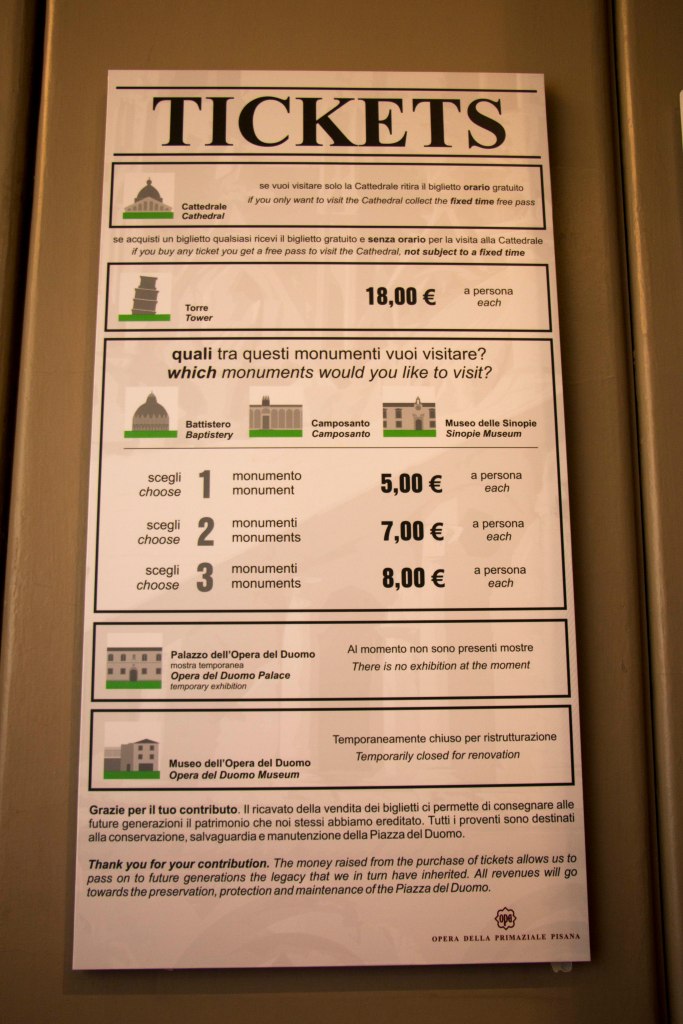
If you observe these buildings carefully, you’ll notice several tiny sculptures, ornaments and carvings all over the walls that are not so conspicuous at first sight.
Ha az ember alaposabban megfigyeli ezeket az épületeket, akkor rengeteg apró szobrot, díszítést és faragást fedezhet fel rajtuk, melyek első ránézésre nem is annyira szembetűnőek.
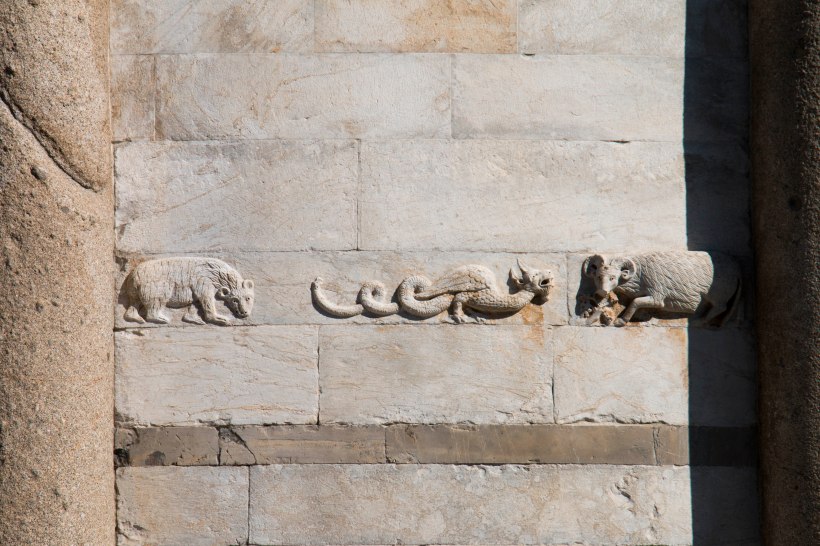
Leaning Tower of Pisa
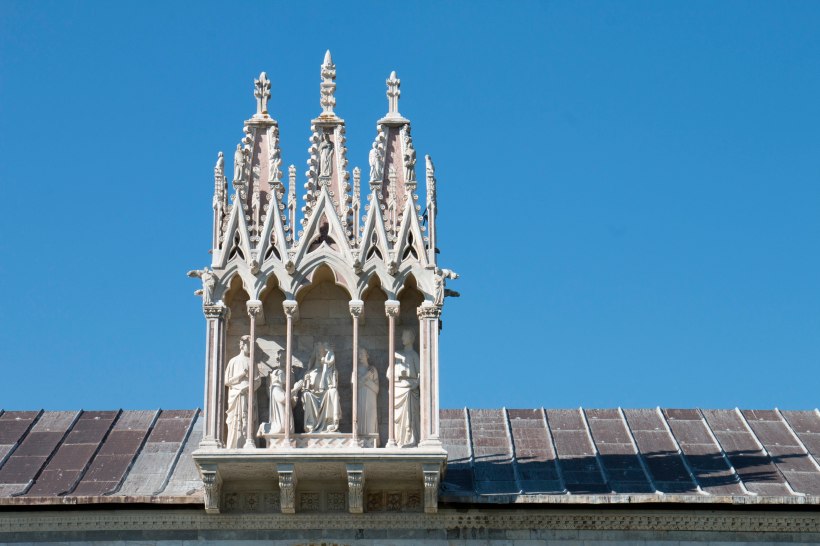
Pisa Camposanto Roof
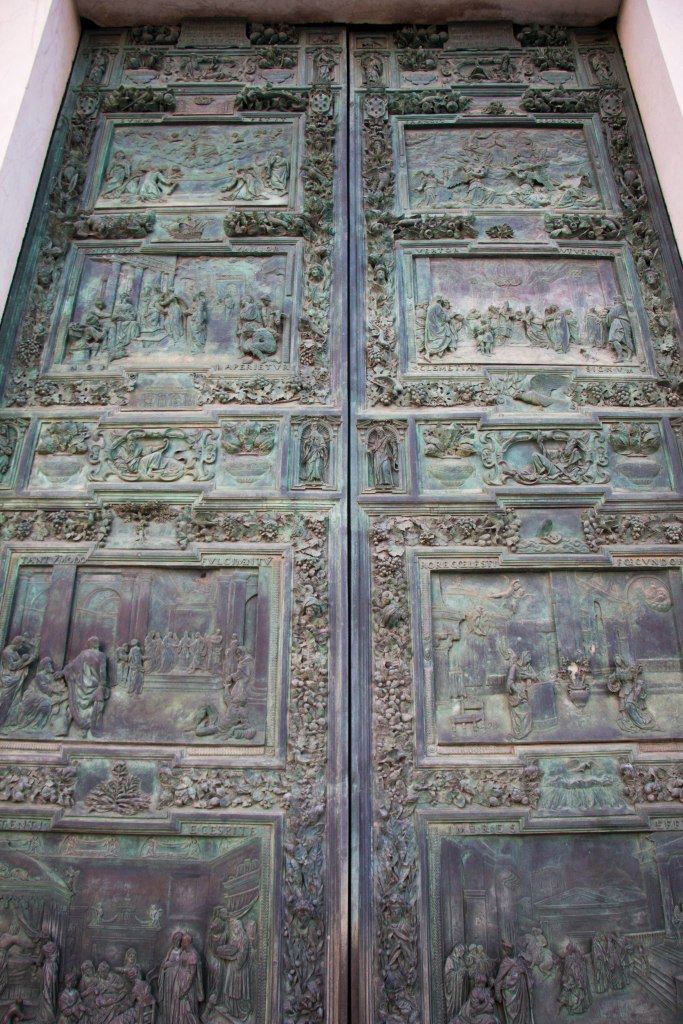
Cattedrale di Pisa
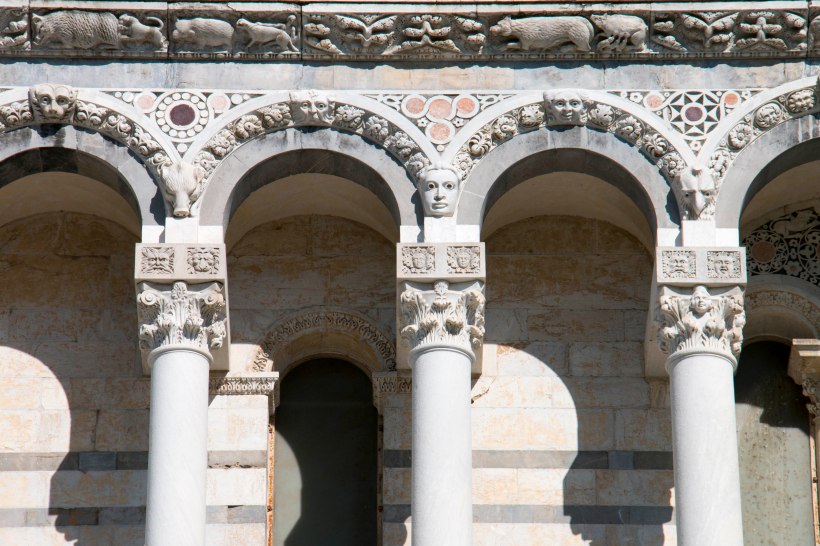
Cattedrale di Pisa
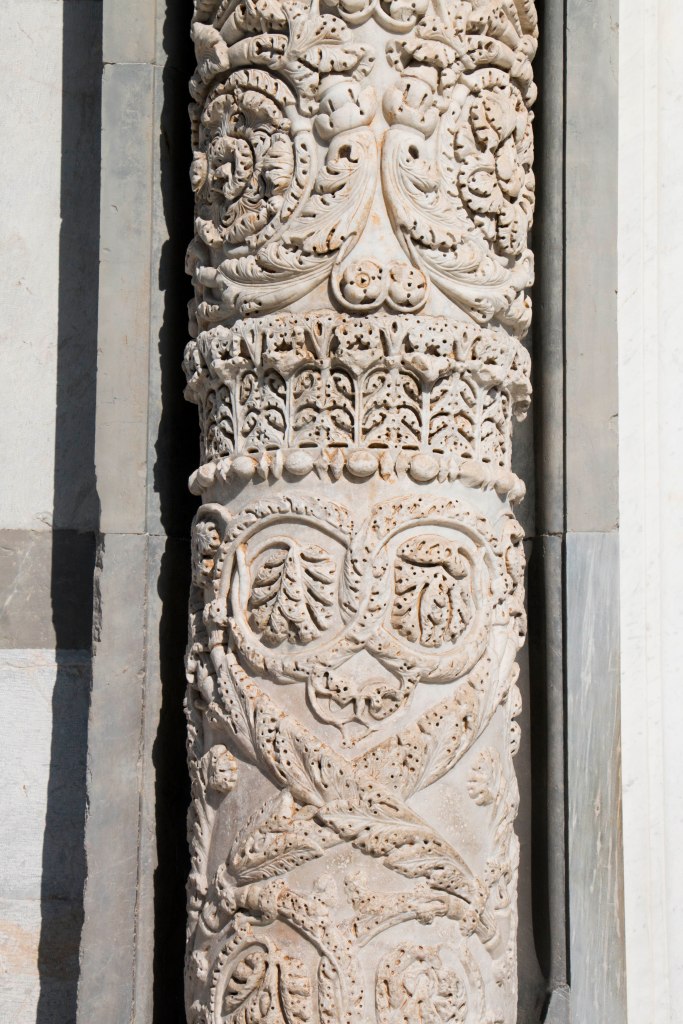
Cattedrale di Pisa
Because we still had a lot of time until our cathedral appointment, we decided to leave the Cathedral Square behind for a while and explore the surrounding area as well. While randomly strolling around the streets we noticed the leaning tower constantly emerging from behind the buildings.
Mivel a sok nézelődés és fotózás után még mindig rengeteg időnk volt a katedrális látogatásig, ezért úgy döntöttünk, hogy egy időre magunk mögött hagyjuk a Dóm teret és felfedezzük a környéket. Az utcákon bandukolva a ferde torony állandóan fel-felbukkant egy-egy épület mögül.
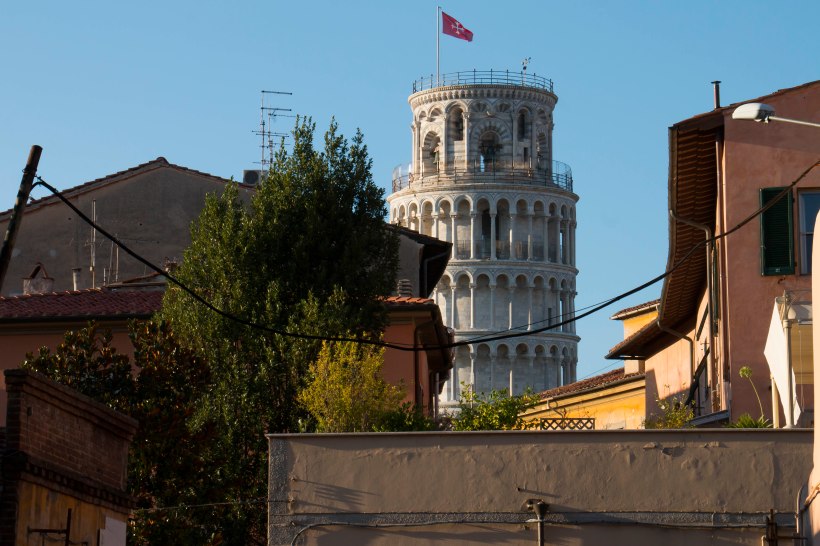
While wandering around we accidentally bumped into the Botanical Garden of Pisa which is actually an arboretum established in the 16th century. It’s not that big and there wasn’t an extreme amount of plants to see, but it was nice to escape for a while from the crowd and the scorching heat, and enjoy the silence and the thick shade of the trees. By the way, the garden is open daily between 9am and 5pm, and the entrance fee is €4 for people and free for cats.
Így tévedtünk el egészen véletlenül a pisai botanikus kertbe, ami igazából egy 16. században létesített arborétum. Nem túl nagy és nincs benne olyan rengeteg látnivaló növény, viszont jó volt ide menekülni a tömeg és a tűző nap elől, és élvezni a csendet meg az öreg fák vaskos árnyékát. Egyébként a botanikus kert naponta 9-től 5-ig van nyitva, és embereknek 4 euró a belépti díj, macskáknak pedig úgy tűnik ingyenes.
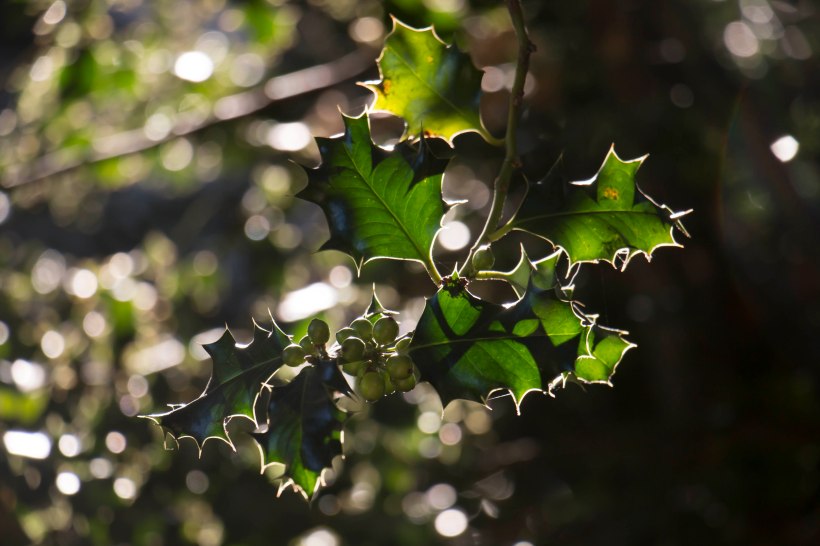
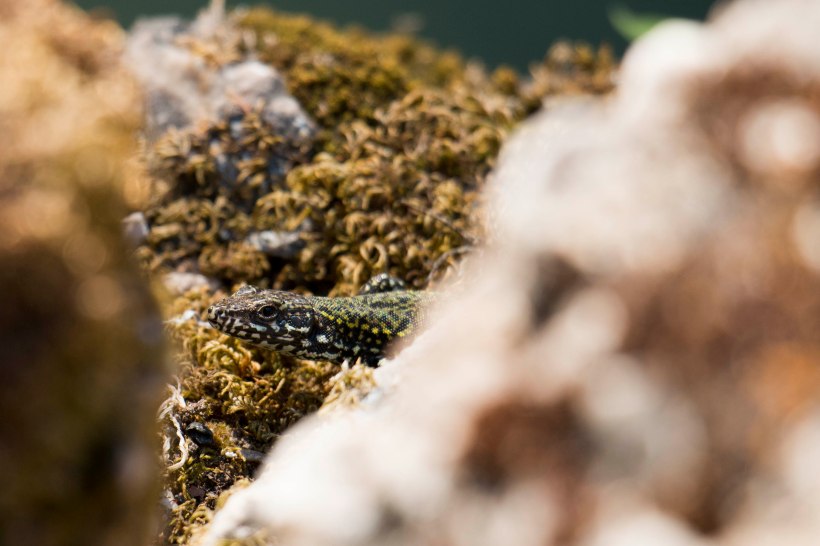
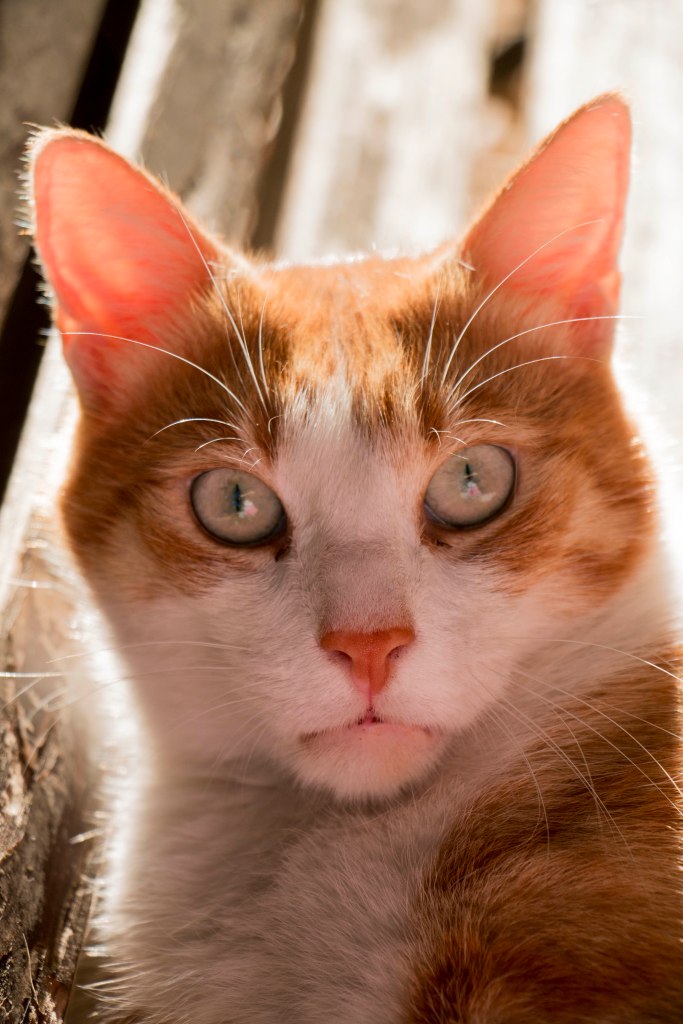
It was near dusk, when we got back to the cathedral. We gained entry with the last group of the day. During our visit the building was getting ready for the closing time, but no one was pressuring us to hurry. We could take our time to look around and enjoy the atmosphere. While we were admiring the interior and I realised that there is no point for me even attempting to take photos in this semidarkness without a tripod, Will suddenly said: “This place is almost exactly like one of the churches in Assasin’s Creed. Oh man, I really wanna play that game now!”
Alkonyodott, mire visszatértünk a dómhoz, és az utolsó csoporttal együtt jutottunk be. Már záráshoz készülődtek, ennek ellenére senki nem stresszelt vagy siettetett. Nyugodtan nézelődhettünk és beszippanthattuk a hely hangulatát. Ahogy a félhomályban a templom belsejét csodáltuk és közben megállapítottam, hogy állvány hiányában a fotózással még próbálkozni sem érdemes, egyszercsak Will megszólalt: “Ez egészen olyan, mint az egyik templom az Assasin’s Creedben. Húúúú de megjött a kedvem, hogy újra játsszam!”.>
While we were exploring the cathedral it got dark outside. On our way home we stopped at a restaurant to have dinner. Before going to bed we made sure to enjoy a few bottles of Aperol Spritz as well. After consuming the content of our mini-fridge, it seemed to be a good idea to prank the cleaner who was going to tidy our room the next day and hide each Aperol bottle in a completely different corner of the room. We’ll never know whether the cleaner found this funny or they hated us, but back then we thought the idea was hilarious.
Mialatt a katedrálisban nézelődtünk kint teljesen besötétedett. Hazafelé sétálva egy étteremben megvacsoráztunk, majd alvás előtt, biztos ami biztos, még legurítottunk “néhány” Aperol Spritzet is. Ezek után persze nagyon jó ötletnek tűnt az üres üvegeket a legkülönbözőbb helyeken elrejteni, ezzel tréfálva meg a szegény takarító személyzetet aki másnap a szobánkat volt hivatott rendbetenni. Azt sajnos soha nem fogjuk megtudni, hogy viccesnek találta-e vagy pedig nagyon utált minket. Mi mindenesetre viccesnek találtuk.
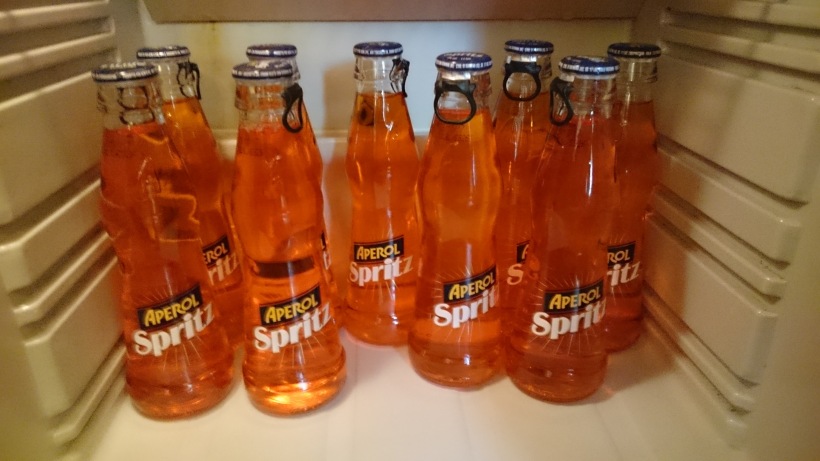
The next morning we decided to take advantage of all our time we have left in Pisa and explore the rest of the city. Because this was the final day of our Italian adventure we felt like wandering around aimlessly while taking photos, drinking coffee and buying a few last things. The moment we moved away from the Cathedral Square we realised that tourists accumulate mainly in that area, whereas the rest of the city is peaceful, quiet and almost deserted. Despite this it has many pedestrianised streets and lots of shops.
Másnap reggel elhatároztuk, hogy amennyire csak lehet bejárjuk a város többi részét is. Mivel ez volt az olaszországi utunk utolsó napja, ezért leginkább csak ahhoz volt kedvünk, hogy céltalanul sétáljunk, fotózzunk, kávézzunk és vásároljunk még pár dolgot. Amint elhagytunk a Dóm tér környékét, egyből feltünt, hogy a pisai turisták kivétel nélkül azon a környéken gyűlnek össze, a város többi része pedig nyugodt, csöndes és majdhogynem kihalt, ennek ellenére rengeteg a sétálóutca és a bolt.
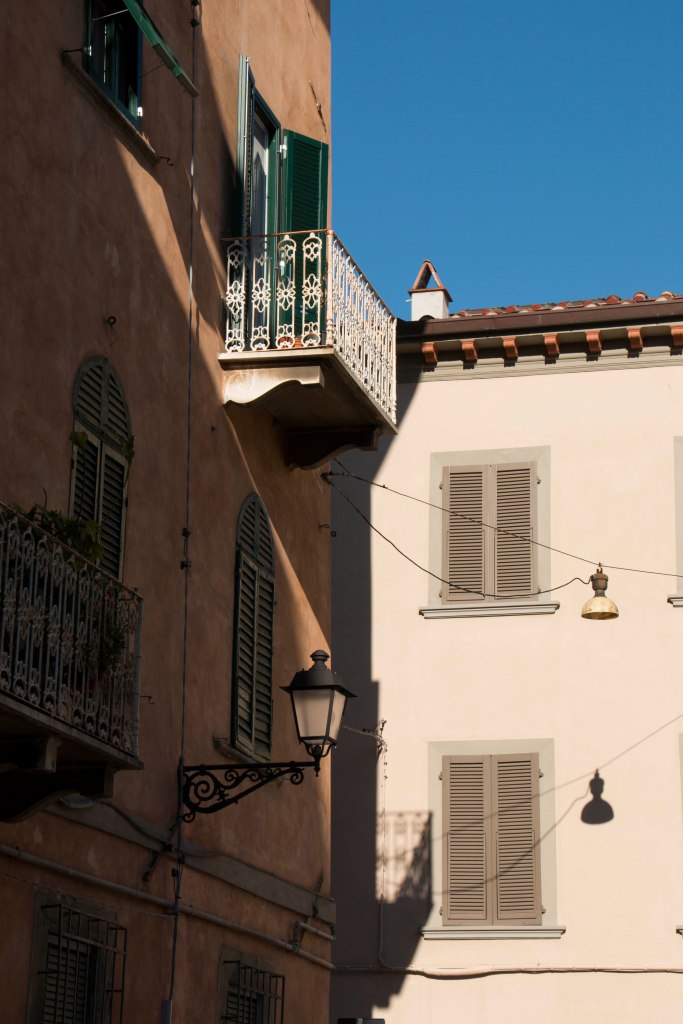
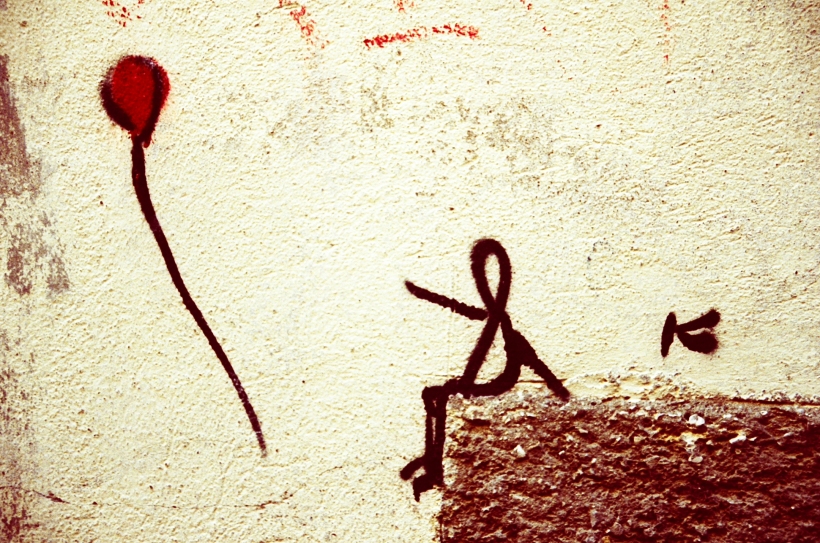
(Photo by Will)
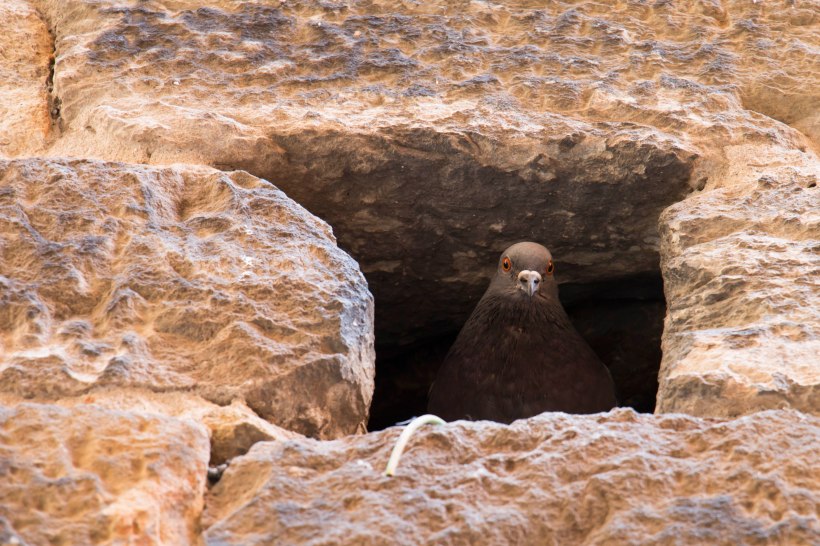

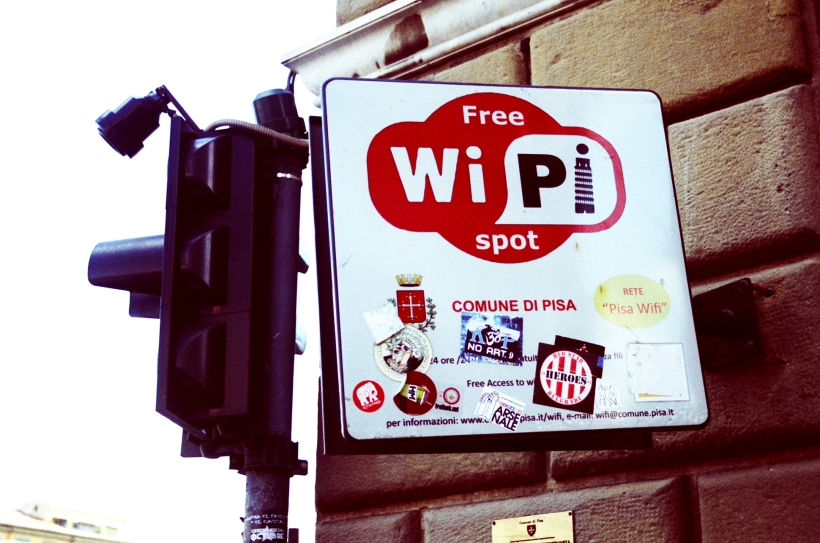
(Photo by Will)
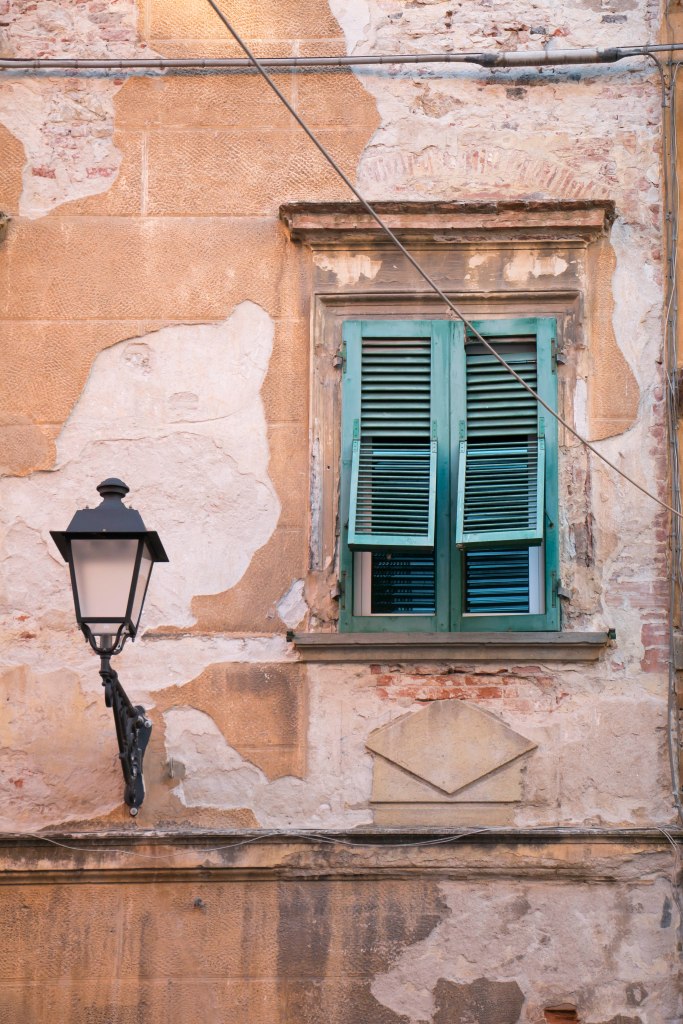

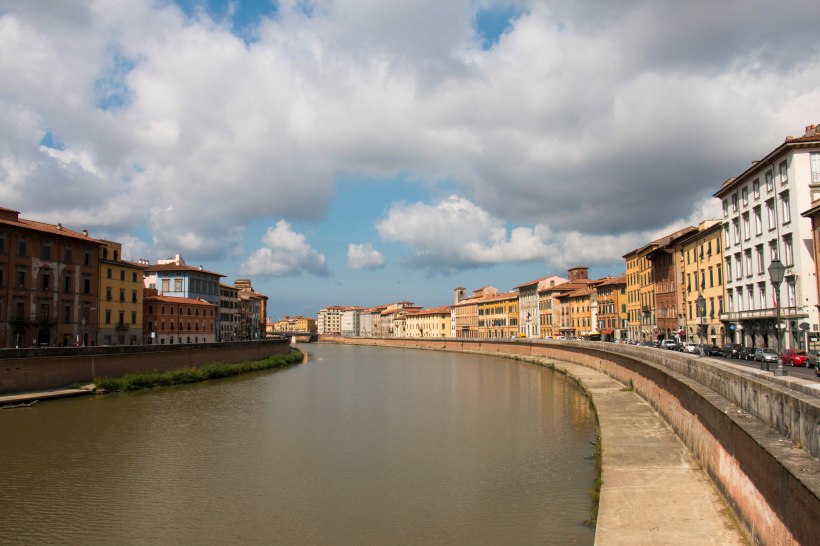
River Arno


Because in the evening we had to catch our flight back to London, towards the afternoon we started planning our journey to the airport, which mainly meant figuring out which bus takes us there and what bus stop do we need to wait at. This task turned out to be more difficult than it sounds. The first bus stop we thought will be good (V.Brennero Porta A Lucca) seemed to be disused because no vehicle turned up for at least half an hour. This was the point when Will and I were desperately running around the area trying to communicate with Italians not speaking a single word of English in order to find out how to get to the “aeroporto”. Eventually, Google helped us out by suggesting an alternative bus stop (Pacinotti 3), which we managed to locate, but we had no idea where to buy a ticket. To be honest, we didn’t even care anymore. We jumped on the bus and arrived to the airport without paying a single penny. It’s possible that the bus driver expressed his disapproval, but we wouldn’t have understood it anyway.
Mivel el kellett érnünk az esti gépet vissza Londonba, ezért a sétálás és vásárolgatás mellett délután már arra kezdtünk el összpontosítani, hogy megtaláljuk azt a buszmegállót illetve buszt ami kivisz a reptérre. Ez nem bizonyult a legegyszerűbb feladatnak, mivel az első buszmegállóba amit kiszemeltünk (V.Brennero Porta A Lucca) több mint fél órán át nem állt be egyetlen jármű sem. Így történt az, hogy kissé kétségbeesetten futkostunk körbe-körbe és próbáltuk faggatni az angolul nem tudó olaszokat, hogy mégis hogyan jutunk el az aeroportoig. Végül kigugliztam egy másik lehetséges buszmegállót (Pacinotti 3), oda is kutyagoltunk, de fogalmunk sem volt, hogy hol lehetne jegyet vásárolni. Viszont ez volt az a pont, mikor már nem is érdekelt. Felpattantunk a buszra, és ingyen és bérmentve döcögtünk ki a reptérre. Közben lehetséges, hogy a buszsöfőr kifejezte nemtetszését a dolog iránt, csak mi ebből semmit sem értettünk.
I think Pisa is my favourite Northern Italian city out of all the places I’ve visited so far. It’s not too big but there are a fair amount of things to see. Additionally, it’s very laid back, spacious, pleasant, clean and friendly, full of shady alleyways, cafes, restaurants, and shops. It pretty much has everything one might need on a relaxing holiday, either as part of a longer trip or simply for a long weekend.
Pisát egyébként talán a kedvenc észak-olaszországi helyemnek tudnám megnevezni. Nem túl nagy, de bőven akad látnivaló. Emellett nyugodt, tágas, kellemes, tiszta, barátságos, tele van árnyékos sikátorokkal, kávézókkal, éttermekkel, sétálóutcákkal és boltokkal, egyszóval minden van itt, amire egy pihenni vágyó embernek szüksége lehet. Tökéletes úticél akár egy hosszabb kirándulás részeként, akár pedig egy hosszú hétvége erejéig.
Finally, I would like to share with you our alternative posing-in-Pisa pictures, cause you know, we have some too, but not from that tickling type.
Ezennel zárom is soraim, de előbb még szeretném megosztani veletek a mi pisai, alternatív, pózolós fotóinkat, mert ugye vannak, csak nem abból a csiklandozós fajtából.


(Photo by Will)

